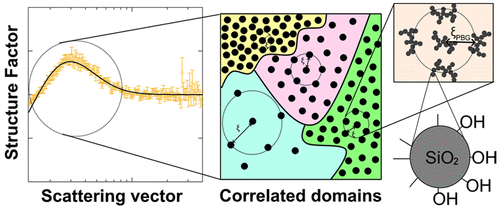当前位置:
X-MOL 学术
›
Macromolecules
›
论文详情
Our official English website, www.x-mol.net, welcomes your feedback! (Note: you will need to create a separate account there.)
Quantification of Dispersion for Weakly and Strongly Correlated Nanofillers in Polymer Nanocomposites
Macromolecules ( IF 5.5 ) Pub Date : 2020-03-13 , DOI: 10.1021/acs.macromol.9b02429 Alex McGlasson 1 , Kabir Rishi 1 , Gregory Beaucage 1 , Michael Chauby 1 , Vikram Kuppa 2 , Jan Ilavsky 3 , Mindaugas Rackaitis 4
Macromolecules ( IF 5.5 ) Pub Date : 2020-03-13 , DOI: 10.1021/acs.macromol.9b02429 Alex McGlasson 1 , Kabir Rishi 1 , Gregory Beaucage 1 , Michael Chauby 1 , Vikram Kuppa 2 , Jan Ilavsky 3 , Mindaugas Rackaitis 4
Affiliation

|
The dispersion of nanoparticles in viscous polymers is dictated by kinetics, interaction potentials between particles, and interfacial compatibility between the matrix and dispersed phases. It was previously proposed that an analogy can be made between thermally dispersed colloids and kinetically dispersed nanoparticles in viscous media when weak interactions exist between particles allowing for a mean-field description under the Ginzburg criterion such as for carbon black dispersed in polybutadiene elastomer. For these cases, the second virial coefficient can be used to quantify the quality of dispersion; additionally, the nanoscale network mesh size can be calculated, which is related to dynamic properties. However, this approach fails for nanoparticles with surface charges or other specific interactions that lead to correlations. Here, these correlated systems are investigated in the context of the mean-field systems in order to gain a comparative description of dispersion using the network mesh size and a derived virial coefficient. The physical origin of the structural parameters from the proposed model for these correlated systems is investigated.
中文翻译:

聚合物纳米复合材料中弱相关性强和相关性强的纳米填料的分散度定量
纳米颗粒在粘性聚合物中的分散取决于动力学,颗粒之间的相互作用电势以及基质与分散相之间的界面相容性。先前曾提出,当颗粒之间存在弱相互作用时,可以在粘性介质中的热分散胶体和动力学分散的纳米颗粒之间进行类比,从而允许根据Ginzburg准则进行平均场描述,例如分散在聚丁二烯弹性体中的炭黑。在这些情况下,第二维里系数可用于量化分散质量。另外,可以计算出与动态特性有关的纳米级网眼尺寸。然而,这种方法对于具有表面电荷或导致相关性的其他特定相互作用的纳米粒子而言是失败的。这里,这些相关系统是在均场系统的背景下进行研究的,目的是使用网络网格大小和导出的病毒系数来获得色散的比较描述。针对这些相关系统,从提出的模型中研究了结构参数的物理起源。
更新日期:2020-03-16
中文翻译:

聚合物纳米复合材料中弱相关性强和相关性强的纳米填料的分散度定量
纳米颗粒在粘性聚合物中的分散取决于动力学,颗粒之间的相互作用电势以及基质与分散相之间的界面相容性。先前曾提出,当颗粒之间存在弱相互作用时,可以在粘性介质中的热分散胶体和动力学分散的纳米颗粒之间进行类比,从而允许根据Ginzburg准则进行平均场描述,例如分散在聚丁二烯弹性体中的炭黑。在这些情况下,第二维里系数可用于量化分散质量。另外,可以计算出与动态特性有关的纳米级网眼尺寸。然而,这种方法对于具有表面电荷或导致相关性的其他特定相互作用的纳米粒子而言是失败的。这里,这些相关系统是在均场系统的背景下进行研究的,目的是使用网络网格大小和导出的病毒系数来获得色散的比较描述。针对这些相关系统,从提出的模型中研究了结构参数的物理起源。



























 京公网安备 11010802027423号
京公网安备 11010802027423号